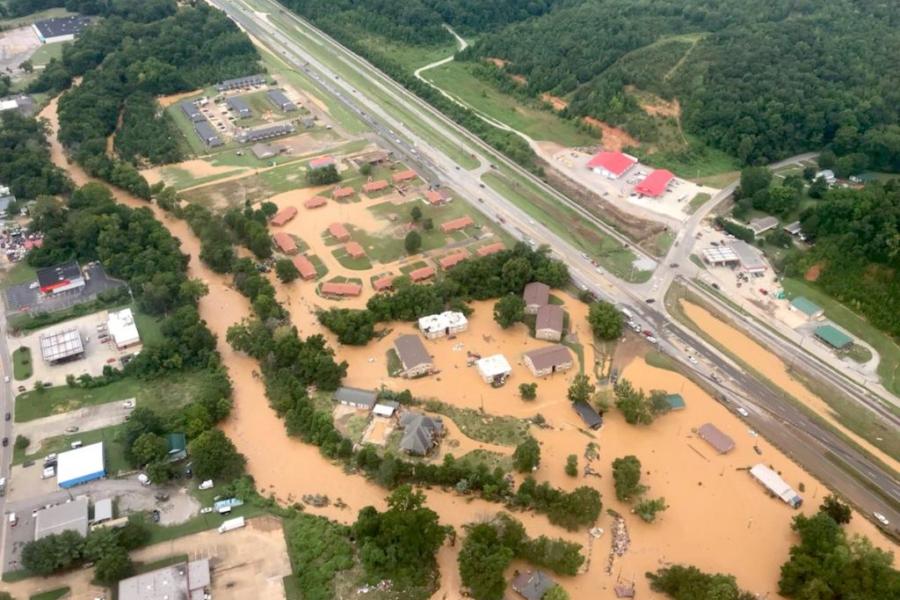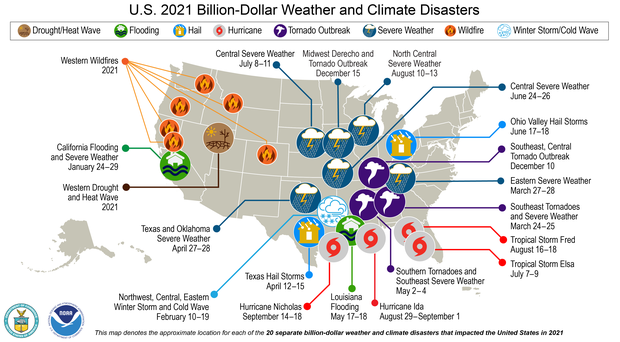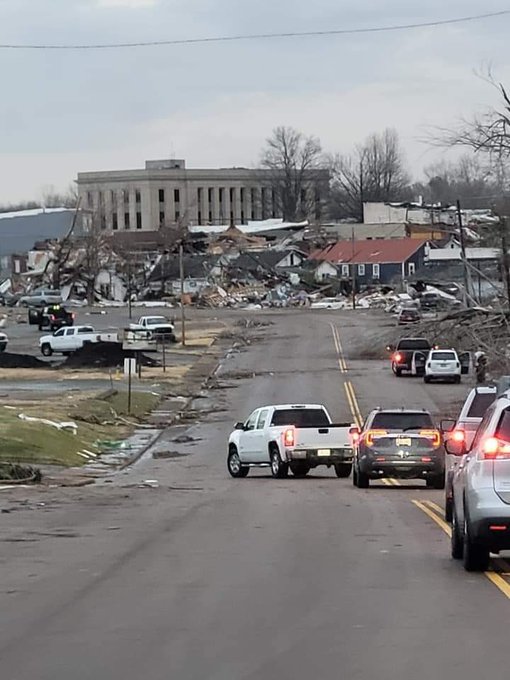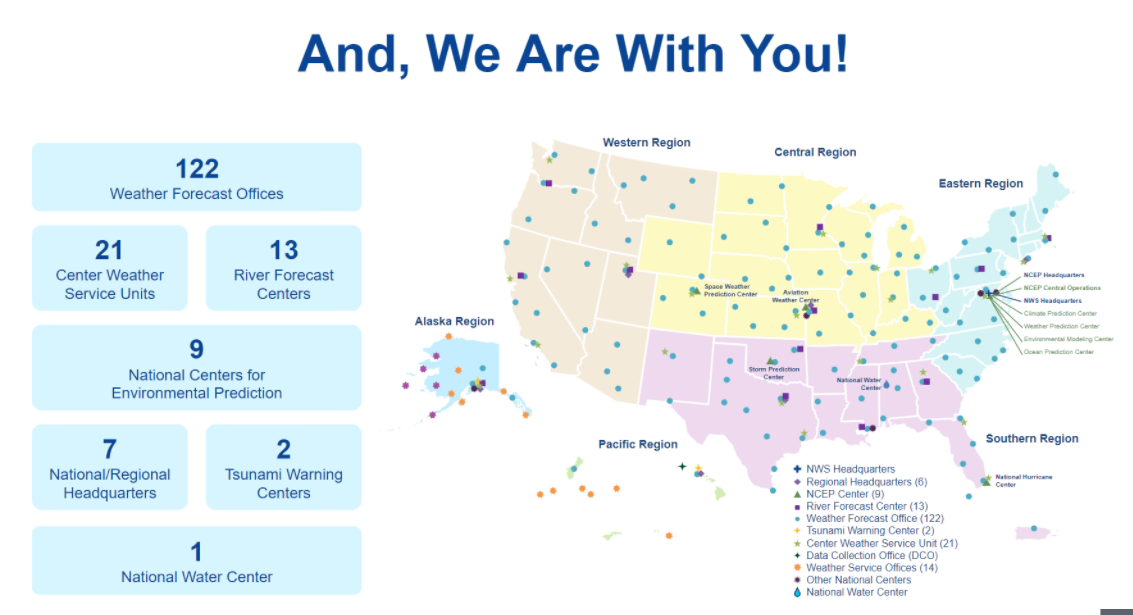NOAA offering resources, expertise to build disaster resilient communities

By KATE COIL
TML Communications Specialist
The National Oceanic and Atmospheric Administration (NOAA) is interested in connecting with and providing resources to local governments to help with climate resiliency and natural disaster planning.
Partnering with the U.S. Department of Commerce, NOAA held a webinar on Extreme Weather and Climate Preparedness with a focus on how NOAA resources and information can help communities build their own Impact-Based Decision Support Services (IDSS).
Dr. Rick Spinrad, undersecretary of commerce for NOAA, said the agency plays a major role in the lives of Americans when they check the weather for the day, plan an outing on the water, or use GPS services.
“We like for folks to think about NOAA about in terms of science, service, and stewardship,” he said. “We focus on everything from the surface of the sun to the bottom of the ocean, and span the nation to touch each of the communities you represent every second of every day. We play a critical role in the lives of Americans in terms of lives, livelihoods, and lifestyles... Our mission as we address challenges such as excessive and unprecedented heatwaves, more extended drought, more severe storms, rising sea levels, and flooding is what makes us more committed to creating what we call a climate ready nation.”

Billion-dollar disasters – natural disaster events where the recovery cost is at least a billion or higher – are at their highest rate in American history. Spinrad said 2020 was a record-breaking year with 22 billion-dollar disasters followed by 20 in 2021. With 15 billion-dollar disasters before October in 2022, the year is on track to make it into the top five years for disaster costs in American history. Since the 1980s, Spinrad said the amount of time America goes between billion-dollar disasters has dropped from 82 days to just 18 days.
“Remember, this is economic impact,” Spinrad said. “The information here is as much about how we want to build resilient communities as it is how weather and climate are behaving. When it’s in your community, it only takes one billion-dollar disaster to disrupt and devastate everything.”
Because of this, Spinrad said NOAA wants to improve impact-based decision support services (IDSS), which is the sharing of information and engagement with private and public partners to “get critical information in the hands of decision-makers so they can make decisions ahead of, during, and following extreme events.”
Ken Graham, assistant director for weather services and director of the National Weather Service, said NOAA officials are often deployed to emergency management centers for the purpose of providing IDSS.
“So often in these cases, we have NOAA employees like meteorologists and hydrologists employed to local emergency management centers, helping with those tough decisions like when to evacuate, where you place resources, what shelters to open,” Graham said. “Really tough decisions are made during these events, and IDSS is all about being there to provide the science to those impacts and provide the risk assessment needed to make those tough decisions in the heat of the battle.”
While most know about the IDSS services provided by the National Weather Service, Spinrad said NOAA is actually behind a wide variety of support services that can help decision makers do what is best for their communities beyond natural disaster events like floods and tornadoes.

Spinrad said NOAA provides a wide variety of information and resources to help with everything from helping elderly and disadvantaged communities during heat waves to helping farmers with drought management and providing GIS data to determining if events like outdoor concerts, festivals, and fairs can go ahead despite weather forecasts.
“Our decision-support services include getting people and places the things they need to understand their vulnerability,” he said. “We provide emergency response support for things like responding to oil spills. Our research work provides a very broad range of support that provides a fundamental basis and contributes to directly improving these decision-support services. It has helped us build things like heat.gov, which is the premiere source for heat and health information aimed at reducing the health, economic, and infrastructure impacts of extreme heat. Our climate resistance toolkit is one of the new products we are building that helps people find the tools they need to make climate-based decisions.”
In the past NOAA has tried to offer a one-size-fits-all approach to the services it provides, but Spinrad said the agency has realized that not all communities are in a position to take advantage of its services.
“Each community is unique with respect to its intrinsic vulnerabilities to things like weather, water, and climate hazards. We are going forward with what we call an equitable services paradigm where we explicitly account for the unique nature of each community and build into our outreach, product development, and education efforts the time of integrated and impact-based support services I have mentioned. So much of this depends on doing this in a co-development manner where we work with communities from the get-go.”
NOAA is working with social and behavioral scientists to look at social vulnerability and what makes communities and residents less likely to be prepared for hazardous weather, less likely to respond to hazardous weather, and slower to recover from disaster events. One of the goals of this program is to provide education where residents underestimate their risk for things like flooding.
“Over the last three years, we have had some big social science projects and that data is coming in as we speak,” Graham said. “The big challenge, in my opinion, is that risk perception. I’ve said so many times in my career during a natural disaster -- if you are asked to evacuate do so. The reality is many people can’t. It goes back to social equity. So many people can’t afford to or there is the comparison to the last one that didn’t happen. There is also situation where people didn’t understand the forecast or don’t speak English. There are people who aren’t able to leave because of their health.”
NOAA also works with other federal agencies, like the U.S. Fish and Wildlife Service, to also provide funding to communities looking to build their resiliency. Spinrad said there are even more resources available now as part of recent federal legislation.
“There is a program called the National Climate Resilience Fund, which is specifically designed for grants for planning on how to be more resilient and even undertaking shovel-ready projects to build more climate-ready communities,” Spinrad. “We just announced the most recent round of these grants where we had 90 grants totaling almost a quarter-of-a-billion dollars.”
For making communities more resilient, Spinrad also recommends community leaders visit climate.gov to see what programs are available via the Climate Ready Nation project and other issues, which brings together the resources of NOAA, NASA, the EPA, and the National Science Foundation to provide communities with resources.

“Climate.gov provides one-stop shopping,” he said. “It answers questions like what is the project for the drought where you live, what is the formal definition of a drought, or what is the U.S. Department of Agriculture doing to address the drought. There are also decision-support tools there to make sure these are all connected. It provides what I call environmental intelligence. It provides people with the information they need to make a decision. Portals like climate.gov provide those tools.”
Another goal for NOAA is building trust with community leaders to help with tough decisions and resiliency plans for communities.
"These relationships don't happen during the event; they happen years ahead of time,” Graham said. “They happen during the exercises and really trying to practice and test things out to build relationships before the next event. You don’t want to meet someone during that disaster. We are there during the event and after the event during the process of recovery and search and rescue. The relationship is continual in these communities.”
Spinrad said community buy-in is necessary to NOAA’s mission, both to provide daily services like forecasts and to build a nation that is more resilient against disaster events.
“We can’t do this alone,” Spinrad said. “This work is much too big and much too diverse for any single sector, organization or agency. As we continue to develop our decision-support services, we are going to rely on our partnerships across all sectors to accomplish the mission of keeping communities prepared for and responsive to extreme weather, water, and climate events. Think about your community’s vulnerability when it comes to extreme events, then reach out to your local NOAA office to see what kind of information and services we can provide to help your community become more resilient.”
For more information on what services NOAA and can provide in your community, visit https://www.noaa.gov/legislative-and-intergovernmental-affairs/noaa-in-your-state-territory. For more information about the U.S. Climate Resilience Toolkit at https://toolkit.climate.gov/.

